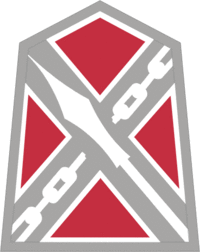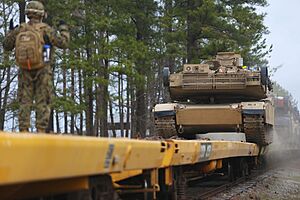Fort Barfoot facts for kids
Quick facts for kids Fort Barfoot (Formerly Fort Pickett) |
|
|---|---|
| Blackstone, Virginia | |

Shoulder sleeve insignia of the Virginia Army National Guard
|
|
| Type | National Guard Training Site |
| Site information | |
| Controlled by | Virginia National Guard |
| Site history | |
| Built | 1942 |
| In use | 1941–present |
| Garrison information | |
| Garrison | Army National Guard Maneuver Training Center |
Fort Barfoot is a training base for the Virginia Army National Guard. It is located near Blackstone, Virginia. This base is home to the Army National Guard Maneuver Training Center.
Fort Barfoot was first named Fort Pickett. It was named after a United States Army officer who was also a Confederate General, George Pickett. The base was one of many U.S. Army places named after Confederate soldiers. A group called The Naming Commission suggested new names for these places. They recommended renaming Fort Pickett to Fort Barfoot. This was to honor Colonel Van T. Barfoot, who received the Medal of Honor. On January 5, 2023, the U.S. Department of Defense officially approved the name change. The renaming ceremony happened on March 24, 2023.
How Fort Barfoot Began
In late 1941, a group of Army surveyors visited a site in Virginia. It was near the small town of Blackstone. They found a lot of land, water, and other things needed for a large training base. This base could train more than one infantry division at the same time. The location also had easy railroad access to both mountain and coastal training areas.
By December 1941, about 45,867 acres (185.61 km2) of land were bought. This land was in Nottoway, Dinwiddie, Lunenburg, and Brunswick Counties. The land was cleared to start building the first structures.
The Virginia National Guard first used what was then Fort Pickett on December 6–7. The 1st Battalion, 116th Infantry, camped there. They were returning to Fort Meade, Maryland, after war games in North Carolina.
Fort Barfoot During World War II
In 1942–1943, two rail lines were built into the camp. This helped move supplies and troops quickly. Air travel became possible with the new Blackstone Army Airfield in late 1942. The airfield had four runways. Each runway was 5,269 feet long and 300 feet wide. This was big enough for Douglas C-47 "Gooney Bird" planes to land safely. No fighter planes were based there, but they could use the runways in an emergency.
By the end of 1942, over 1,400 buildings were finished. These included about 1,000 barracks for enlisted soldiers and 70 homes for officers. There were also 12 chapels, a large hospital, and six firehouses. Warehouses, headquarters, and offices were also built. The Army built its own water and sewage plants. This made sure the base had enough water for up to 60,000 soldiers. In the 1980s, the town of Blackstone took over these facilities.
For fun, soldiers had four movie theaters and a gym. There were also several clubs for enlisted soldiers. A main store (Post Exchange) and smaller stores were available. By the end of the war, over 300 more buildings were added. These included barracks for women and facilities for two prisoner-of-war camps.
Fort Barfoot in the Cold War and Beyond
After World War II, it seemed Camp Pickett might close. But the Cold War started, and there was a need to train large reserve component units. This gave the base a new purpose. In 1950, the 43rd Infantry Division, a National Guard division, came to Camp Pickett for training. In 1951, this division went to Germany.
In 1960, parts of Camp Pickett were updated. This was to house battalions that came for short training periods. This included not only Guard and Reserve units, but also Navy and Marine Corps personnel. These groups still use Fort Barfoot's facilities today.
The Virginia National Guard Maneuver Training Center started at Fort Barfoot in 1961. Its main job was to store and maintain equipment like tanks. This way, visiting units could use them without having to bring their own heavy machines.
In 1974, two important things happened. First, "Camp Pickett" became "Fort Pickett." This showed its new role in training active duty forces every year. Second, the first new building since the Korean War was completed. Building 467 was made of brick and had living spaces, a dining hall, and offices.
Ten years later, a new set of barracks and support buildings was finished. This complex was big enough for an entire brigade. It was named on June 8, 1984. This honored Tech. Sgt. Frank D. Peregory of the 116th Infantry. He earned the Medal of Honor 40 years earlier during the D-Day invasion.
Other improvements were made. The telephone system was doubled in 1991. The Blackstone Army Airfield runways were updated in 1994. This allowed larger planes like the C-130 and C-17 to land. This made it easier for troops and equipment to arrive for training.
In recent years, more buildings were added or changed. This helped meet the base's changing needs. A new firehouse was built. An NCO Club was renovated to become a community center. Local town events and base functions are held there. Good relationships with the community have always been important for Fort Barfoot.
The base has greatly changed the lives of people in Blackstone. It has created many good jobs. It also supports the town in other ways. For example, it hosts fishing trips for older people at its lakes. It also holds Fourth of July celebrations. Boy and Girl Scouts have camped, fished, and hiked on the nature trails for many years. Many activities still bring local people and former staff to the base.
Fort Barfoot also hosts an annual exercise called Exercise Maroon Raider. This exercise includes parts of the 36 Canadian Brigade Group and 37 Canadian Brigade Group. It also involves parts of the U.S. Military. This training helps prepare soldiers for combat. It includes live-fire drills, combat movements, and other battlefield tactics.
While Fort Barfoot mainly trains military personnel, other groups use its facilities too. These include the U.S. Department of State, the United States Marshals Service, the FBI, and the ATF. The Virginia Wing of the Civil Air Patrol, Virginia State Police, and local police also train here.
In 1995, the decision was made to turn over Fort Pickett to the Virginia National Guard. This happened in 1997. Since then, no regular Army personnel have been stationed at Fort Barfoot. This was the first time since January 1942.
The 183rd Regiment manages the Virginia RTI at Fort Barfoot.



